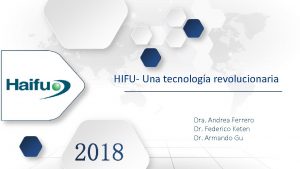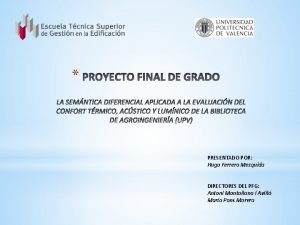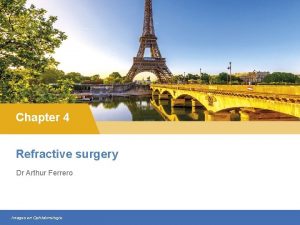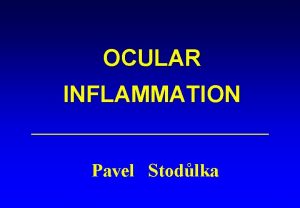Chapter 3 Ocular surface Dr Arthur Ferrero Images






- Slides: 6

Chapter 3 Ocular surface Dr Arthur Ferrero Images en Ophtalmologie

ESCRS Evaluation of a new platform for quantifiying the ocular surface (1) • There is no actual standard for quantification of ocular surface – MGD main cause of dry eye (increased with age) – Subjective assessment (slit-lamp examination, grading of meibum) • Interferometry for meibography – Pioneer: Lipiflow® and Lipi. Scan® – New platform evaluated: Lacry. Diag® (Quantel) • “Low-cost”, 4 min evaluation, delegable • 4 levels of analysis – Interferometry: LTT (lipid layer) – Tear meniscus (mm) (aqueous layer) – Noninvasive BUT (mucin layer) – Meibography sup and inf Images en Ophtalmologie ESCRS 2019 – Adapted from Cochener-Lamard B et al. , Free Paper Session, Anterior Segment Imagine 2

ESCRS Evaluation of a new platform for quantifiying the ocular surface (2) Lacry. Diag® study • Objective – To compare ocular surface clinical sign and Lacry. Diag® measurement Interferometry N. I. B. U. T • Methods – Monocentric study, intermediate analysis at 1 month – 100 patients – Clinical examination: Lacry. Diag®, TBUT, Oxford score, MGE, Schirmer and life questionnaire: OSDI & SPEED Tear meniscus Meibography • MGD prevalence in this group – Clinical: 42 % – Symptomatic (OSDI > 18): 48 % – % of atrophy (Lacry. Diag®): 49 % Images en Ophtalmologie ESCRS 2019 – Adapted from Cochener-Lamard B et al. , Free Paper Session, Anterior Segment Imagine 3

ESCRS Evaluation of a new platform for quantifiying the Ocular surface (3) Clinical and Lacry. Diag® correlation • Tear stability – No correlation was found between the clinical T-BUT and the noninvasive Lacry. Diag® BUT (NI-BUT) • Difference T-BUT NI-BUT: 2. 35 ± 0. 99 s • Meibography – Correlation between the meiboscale (1. 23 ± 0. 70) and the % of gland loss, Lacri. Diag® (25 ± 18. 38 %) • Rho = 0. 595 Degree 0 ≈0 % Degree 1 ≤ 25 % Degree 2 26 %-50 % Lost 75 -100 % Lost 50 -75 % Lost 25 -50 % Degree 3 51 %-75 % Degree 4 >75 % Images en Ophtalmologie Lost 0 -25 % ESCRS 2019 – Adapted from Cochener-Lamard B et al. , Free Paper Session, Anterior Segment Imagine 4

ESCRS Evaluation of a new platform for quantifiying the Ocular surface (4) Conclusion • Parameters in accordance with the DEWS II recommendations – Interest: quantitative of subjective parameters – Interesting in MGD diagnosis (under estimation of MGD by clinical exam) • Current limit – Threshold of normality to define – Probably not correlated with clinical values Images en Ophtalmologie ESCRS 2019 – Adapted from Cochener-Lamard B et al. , Free Paper Session, Anterior Segment Imagine 5

EURETINA ESCRS Disclasme of interest • Dr Louis Arnould declares that he has no conflicts of interest • Dr Elodie Bousquet declares that she has no conflicts of interest • Dr Arthur Ferrero declares that he has no conflicts of interest • Pr Nicolas Leveziel declares that he has no conflicts of interest • Dr Elise Philippakis declares that she has no conflicts of interest • Dr Alain Saad declares that he has no conflicts of interest Images en Ophtalmologie 6










